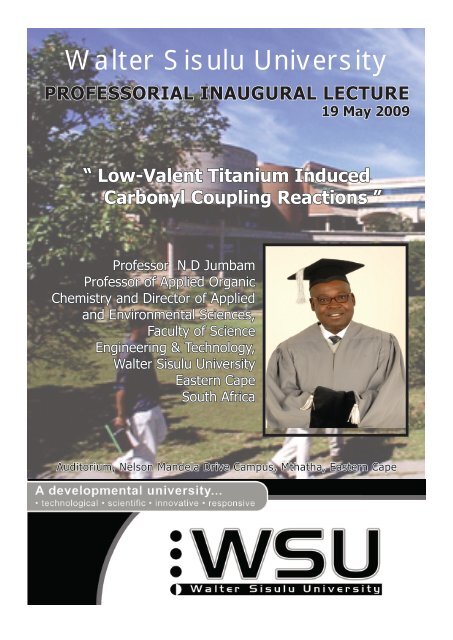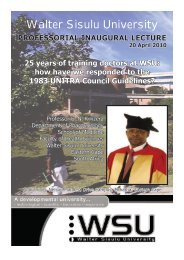Low-Valent Titanium Induced Carbonyl Coupling Reactions
Low-Valent Titanium Induced Carbonyl Coupling Reactions
Low-Valent Titanium Induced Carbonyl Coupling Reactions
You also want an ePaper? Increase the reach of your titles
YUMPU automatically turns print PDFs into web optimized ePapers that Google loves.
Walter Sisulu University<br />
PROFESSORIAL INAUGURAL LECTURE<br />
19 May 2009<br />
“ <strong>Low</strong>-<strong>Valent</strong> <strong>Titanium</strong> <strong>Induced</strong><br />
<strong>Carbonyl</strong> <strong>Coupling</strong> <strong>Reactions</strong> ”<br />
Professor N D Jumbam<br />
Professor of Applied Organic<br />
Chemistry and Director of Applied<br />
and Environmental Sciences,<br />
Faculty of Science<br />
Engineering & Technology,<br />
Walter Sisulu University<br />
Eastern Cape<br />
South Africa<br />
Auditorium, Nelson Mandela Drive Campus, Mthatha, Eastern Cape
WALTER SISULU UNIVERSITy (WSU)<br />
FACULTy OF SCIENCE, ENGINEERING ANd TEChNOLOGy<br />
SChOOL OF APPLIEd ANd ENVIRONMENTAL SCIENCES<br />
dEPARTMENT OF ChEMISTRy ANd ChEMICAL<br />
TEChNOLOGy<br />
TOPIC<br />
LOW-VALENT TITANIUM-INdUCEd CARbONyL COUPLING<br />
REACTIONS<br />
by<br />
NdzE dENIS JUMbAM<br />
PROFESSOR OF APPLIEd ORGANIC ChEMISTRy<br />
dATE: 19 MAy 2009<br />
VENUE: WSU AUdITORIUM<br />
3
LOW-VALENT TITANIUM-INdUCEd<br />
CARbONyL COUPLING REACTIONS<br />
The Vice Chancellor,<br />
Deputy Vice Chancellor, Academic Affairs and Research,<br />
Deputy Vice Chancellor, Planning, Quality Assurance and Development<br />
Registrar<br />
Executive Deans of Faculties,<br />
Directors of Schools,<br />
Heads of Departments,<br />
Students,<br />
Members of the University Community and Colleagues,<br />
Distinguished Guests,<br />
Friends,<br />
Ladies and Gentlemen<br />
It is my pleasure to stand here before you to give this inaugural lecture on behalf of the<br />
Department of Chemistry and Chemical Technology in the New School of Applied and<br />
Environmental Sciences. I happen to be the founding Director of this new school which is<br />
located in the Faculty of Science, Engineering and Technology. I feel honoured to present the<br />
first inaugural lecture from my faculty.<br />
My teaching and research interest lies principally in applied chemistry. In this field, I research<br />
and develop new processes as well as improving upon the efficacy of existing ones. I also<br />
have a vested interest in indigenous knowledge systems more particularly natural product<br />
chemistry. This is not surprising given my background in herbal medicine.<br />
For many years I have worked on metal activated reactions in organic synthesis, where the<br />
chemistry of zinc- and silver on graphite was considerably extended. Today I am paying<br />
particular attention to titanium metal, its brief history and the role it has played and continue to<br />
play in carbonyl coupling reactions. I will give an overview of the literature on this, followed<br />
by contributions that I have made alongside other researchers.<br />
1. INTROdUCTION<br />
Interest in the use of low-valent titanium species as reagents in organic synthesis began with<br />
Van Tamelen and his research team in 1965, when they reported the first ever low-valent<br />
titanium-induced reductive dimerization of alcohols to give hydrocarbons [1]. In the early<br />
seventies shortly after the Van Tamelen report, the research teams of Mukaiyama,[2] Tyrlik[3]<br />
and McMurry[4] made the independent and simultaneous discovery that ketones and aldehydes<br />
undergo reductive dimerization to yield olefins on treatment with low-valent titanium reagents.<br />
Particularly McMurry and his co-workers [5,6,7] have extensively investigated this reaction,<br />
5
therefore this process is now generally referred to as the “McMurry reaction” (scheme 1).<br />
6<br />
2<br />
Scheme 1<br />
O<br />
R R'<br />
R, R" = H, alkyl or aryl<br />
"low-valent Ti"<br />
Since its discovery, this reaction has served as an important carbon-carbon bond forming<br />
process and now finds wide applications in organic synthesis.<br />
2. LOW-VALENT TITANIUM REAGENTS<br />
Preparation<br />
Within the area of metal-catalysed reactions, an increasing interest is addressed to the use<br />
of highly active zerovalent metals[8]. The efficiency of these reactions depends on the<br />
active surface area of the metal used, which is a direct function of their degree of dispersion.<br />
Rieke and co-workers[9,10] developed a method for generating metal suspensions by the<br />
reduction of the respective metal salts with an alkali metal in ethereal or hydrocarbon solvents<br />
(scheme 2).<br />
MXn + nK M + nKX<br />
MXn + nK M + nKX<br />
Scheme 2<br />
For most of the reported cases, potassium was used as the reducing agent and THF as the<br />
solvent. Lumps of potassium metal and the respective metal salt were heated in dry THF under<br />
an atmosphere of argon. The reduction was said to be complete within a few hours and the fine<br />
black suspension of the respective metal was produced. In some cases, the alkali metal salt<br />
generated in the reduction was said to have a harmful effect on the desired reactions[9]. Metal<br />
suspensions obtained by the Rieke method represent an important breakthrough in the history<br />
of metal activation. It was this method that offered the possibility of preparing the relatively<br />
active Rieke-titanium by heating titanium trichloride and potassium in THF. One of the greatest<br />
disadvantages of this method is the highly exothermic nature of these reactions which are<br />
liable to run away especially when working with large quantities. Moreover, sintering and<br />
agglomeration of the catalyst is of major concern[11]. The Rieke method, though not without<br />
R<br />
R'<br />
R<br />
R'<br />
+<br />
TiO 2
problems, thus opens up the way for the fine dispersion of metals on various supports. Graphite<br />
is one of the commonly used supports nowadays. It is capable of intercalating foreign atoms,<br />
molecules and even metals[12,13]. The most commonly used potassium-graphite intercalation<br />
reagent C 8 K shows an interlayer distance of 5.3Å[12] and all carbon layers are separated by a<br />
layer of potassium (scheme 3)<br />
Scheme 3<br />
It is now generally accepted that the alkali metal atoms diffuse in the intercalation process from<br />
the periphery of the graphite layers into part or all of the interlayer spacing. The preparation of<br />
the metal-graphite reagents is carried out in two steps:<br />
The generation of the bronze coloured C 8 K[12,14] at 150 0 C under a flow of argon<br />
(scheme 4):<br />
MXn + nK 150 0C, Ar M + nKX<br />
K + 8 C (graphite) C8K Scheme 4<br />
The reduction of the respective metal salt by C 8 K under an atmosphere of argon under reflux<br />
(scheme 5):<br />
MXn + nK M + nKX<br />
n C +<br />
8K MXn C +<br />
8nM n KX<br />
Scheme 5<br />
7
In this way, the metal generated is finely dispersed on the graphite surface layer and is highly<br />
reactive. Thanks to this method, the chemistry of titanium[12] amongst other metals has been<br />
considerably extended.<br />
Despite this progress, a full examination of the literature reveals many ambiguities, be it in the<br />
reaction mechanism, choice of solvent, different reducing agents for titanium salts, selectivity<br />
of product formation, substrate and reagent reactivity, just to name a few. At this stage, the<br />
following is noteworthy:<br />
There is evidence that “Rieke-titanium”[9] suitable for the McMurray reactions, can only<br />
be obtained directly from TiCl 3 . Its reduction is usually carried out by using metals such<br />
asLi[15,16,17], Na[15], K[5,6,15], Mg[3,15], Zn/Cu-couple[6]. The reduction of TiCl 3 with<br />
LiAlH 4 [4,18], or TiCl 4 with any of the above mentioned reducing agents invariably affords<br />
“low-valent titanium” salts[15].<br />
Considering the fact that in some cases the same McMurry procedure is applied to greatly<br />
differing coupling problems there is, in turn, no obvious reason for the various reagent<br />
preparations described for the same type of reduction. This discrepancy is exemplified by<br />
the cyclization procedures used for either diketones[6] or ketoesters[19] by two reagent<br />
combinations as far apart as TiCl 3 /Zn-Cu-couple/THF[6] or TiCl 3 /LiAlH 4 /TEA/DME[19] are<br />
employed despite the completely analogous mechanisms of these reductions[19].<br />
When low-valent titanium reagents are used for pinacolisation[20] reactions, they tend to form<br />
olefinic by-products.<br />
In the reduction of titanium salts by Zn/Cu-couple or LiAlH 4 , the presence of lewis acids had<br />
been found to have an adverse effect[21] on McMurry reactions. The use of triethyl amine<br />
(TEA)[9] in this reaction system might be to neutralize the acid.<br />
The use of C 8 K[22] as the intermediate reducing agent for titanium salts completely avoids the<br />
introduction of the lewis acid species into the reaction system.<br />
The use of sodium-naphthalene[21] as the intermediate reducing agent has been reported to be<br />
a good alternative. However, this method presents a major setback during workup since large<br />
quantities of naphthalene must be separated from the desired product. This can be tedious,<br />
time consuming and can cause reduced yields.<br />
Mechanism of the <strong>Carbonyl</strong> <strong>Coupling</strong> <strong>Reactions</strong><br />
The carbonyl coupling reactions is a two step process viz:<br />
The reductive dimerization of the starting carbonyl compound with formation of the carboncarbon<br />
bond.<br />
8
2<br />
O<br />
R R'<br />
2 x e-<br />
2<br />
O-<br />
R R'<br />
.<br />
Deoxygenation of the titanium pinacolate intermediate to form the corresponding alkene.<br />
R<br />
O-<br />
R'<br />
O-<br />
R<br />
R'<br />
R<br />
R'<br />
The first step is simply a pinacol reaction and is not unique to low-valent titanium. It is<br />
known[23] as far back as1859 that various metals are capable of adding an electron to a carbonyl<br />
carbon atom forming a “ketyl” which subsequently dimerizes. Evidence for this first step in<br />
the titanium-induced coupling reaction is straightforward, since the intermediate pinacols had<br />
been isolated by carrying out the reaction at 0 0 C[24].<br />
R<br />
R<br />
R'<br />
O-<br />
R'<br />
O-<br />
R<br />
R'<br />
9
Table 1. <strong>Titanium</strong>-induced Intramolecular Pinacol <strong>Coupling</strong> <strong>Reactions</strong>[24<br />
Entry Dialdehyde Pinacol Cis/trans ratio Yield (%)<br />
1<br />
2<br />
5<br />
3<br />
4<br />
6<br />
10<br />
CHO<br />
CHO<br />
CHO<br />
CHO<br />
CHO<br />
CHO<br />
CHO<br />
CHO<br />
CHO<br />
CHO<br />
CHO<br />
CHO<br />
OH<br />
OH<br />
OH<br />
OH<br />
OH<br />
OH<br />
OH<br />
OH<br />
OH<br />
OH<br />
OH<br />
OH<br />
100 : 0<br />
25 : 75<br />
70 : 30<br />
25 : 75<br />
5 : 95<br />
30 : 70<br />
Upon treatment of pinacols with active titanium at solvent refluxing temperature, they are<br />
readily deoxygenated to yield the corresponding alkene. The reaction follows an intermolecular<br />
pathway on monocarbonyl compounds to yield acyclic alkenes and on high dilution an<br />
intramolecular pathway on dicarbonyl compounds to yield cycloalkenes[25]. As substrates,<br />
dialdehydes, diketones and ketoaldehydes can be used.<br />
In the process of the alkene formation, the two C-O bonds do not appear to break at the<br />
same time and a mixture of cis- and trans-alkenes is produced starting from a diol of known<br />
stereochemistry[24]. Furthermore, the two oxygen atoms of the pinacol must be able to<br />
approach and bond to the titanium surface. Thus, the cis isomer of 9,10-decalindiol reacts<br />
smoothly with low-valent titanium to yield the anticipated olefin but the trans isomer does not<br />
react even on prolonged treatment. The two oxygens of the cis isomer are in close proximity<br />
while does of the trans are prevented by the steric hindrance from coming in contact with the<br />
titanium surface.<br />
85<br />
80<br />
82<br />
75<br />
83<br />
89
OH CH3 OH CH3 1<br />
OH<br />
OH<br />
2<br />
=<br />
=<br />
HO<br />
OH<br />
OH<br />
OH<br />
Ti<br />
Ti<br />
No reaction<br />
3. InterMOLECULAR COUPLING OF ALdEhydES ANd KETONES<br />
3.1 Synthesis of Alkenes<br />
In his effort to develop an alternative process to Wolff-Kishner reaction, McMurry and his<br />
team[7] subjected enone (4) to TiCl 3 /LiAlH 4 and to their surprise, obtained a hydrocarbon, not<br />
the one they anticipated but a reductively dimerized triene (5) in 80% yield.<br />
O<br />
4<br />
CH 3<br />
TiCl 3/LiAlH 4<br />
While McMurry was not alone at the time in making this fundamental discovery[2,3], he was<br />
however, quick to ascertain the potential of his discovery and embarked on exploring the scope<br />
of the new reaction. He soon realised that the reductive coupling reaction was not limited to<br />
α,β-unsaturated ketones but was general for all kinds of ketones and aldehydes and that the<br />
titanium reagent did not isomerize olefin geometry[7].<br />
CH 3<br />
5<br />
3<br />
CH 3<br />
80 %<br />
11
Dimestrole (7), a precursor of diethylstilbestrol is readily prepared from the ketone (6)[5,6]<br />
O<br />
6<br />
12<br />
OMe<br />
CH 3<br />
TiCl 3/LiAlH 4/THF<br />
95 %<br />
MeO<br />
3.1.1 Synthesis of Strained Alkenes<br />
7<br />
CH 3<br />
C<br />
H 3<br />
The coupling of ketones with low-valent titanium reagent to form alkenes is generally effective<br />
for simple ketones. In sterically hindered ketones, however, the yields are generally low (table<br />
2) and alternative synthetic routes have been unsuccessful for some of these compounds.<br />
OMe
Table 2. Synthesis of Strained Olefins[24]<br />
Entry Substrate Product<br />
1<br />
2<br />
3<br />
4<br />
5<br />
6<br />
O<br />
O<br />
O<br />
O<br />
O<br />
O<br />
To date the synthesis of tetra-tert-butylethylene remains elusive!<br />
O<br />
Ti[<br />
Ref.<br />
26, 27<br />
31<br />
28<br />
29<br />
30<br />
32<br />
13
3.1.2 Mixed <strong>Carbonyl</strong> <strong>Coupling</strong> <strong>Reactions</strong><br />
Intermolecular carbonyl coupling reactions are usually limited to the preparation of symmetrical<br />
olefins by the reductive dimerization of a ketone or an aldehyde. A mixture of two different<br />
carbonyl compounds will react generally to a nearly statistical mixture of olefins when subjected<br />
to low-valent titanium[33,34]. For the purposes of synthesis, such mixed couplings are only<br />
useful only if one component is used in excess and if the products are easily separable[24].<br />
For example, mixed coupling of acetone with a chiral α,β-unsaturated ketones like (R)-(-)-<br />
(4-methylcyclohexylidene)acetone affords a diene (9)initially prepared by Walborsky for<br />
chiroptical study[35].<br />
C<br />
H 3<br />
14<br />
8<br />
C<br />
H 3<br />
H<br />
O<br />
+<br />
C<br />
H 3<br />
O<br />
TiCl 4/LiAlH 4<br />
CH 3<br />
C<br />
H 3<br />
C<br />
H 3<br />
Another example of a mixed coupling reaction is the reaction of an equimolar amount of 2,6dimethyl-2-cyclohexenone<br />
(10) and formyl(trimethylsilyl)cyclopropane (11) with low-valent<br />
titanium. Paquette[36] prepared sesquiterpene vetispirene (12) by this method with a yield of<br />
60%. There is however, no apparent justification why the mixed product should be so strongly<br />
favoured over the symmetrical products in this case.<br />
C<br />
H 3<br />
10<br />
O<br />
CH 3<br />
+<br />
11<br />
SiMe 3<br />
CHO<br />
TiCl 3/Zn-Cu<br />
60 %<br />
9<br />
CH 3<br />
CH 3<br />
C<br />
H 3<br />
H<br />
SiMe 3<br />
Mixed carbonyl coupling reaction has paved the way for the synthesis of the antitumor agent<br />
tamoxifen (15) and several of its analogs[37,38].<br />
12<br />
CH 3
CH 3<br />
13<br />
O<br />
+<br />
O<br />
X R<br />
14<br />
3.1.3 Functional Group Compatibility<br />
R = OCH 2CH 2NMe 2<br />
C<br />
H 3<br />
X R<br />
15<br />
X = H, Tamoxifen<br />
Several easily reducible functional groups do not survive in the presence of low-valent titanium<br />
due to the strong reducing potential of this reagent.<br />
Acetal. Not many carbony coupling reactions are known to take place in the presence of<br />
acetal groups[]. Clive reported[39] the coupling of acetal (16) in the course of compactin (17)<br />
synthesis.<br />
OHC<br />
OSMDBT<br />
16<br />
OSiEt 3<br />
O<br />
O<br />
O<br />
CH 3<br />
CH 3<br />
CH 3<br />
TiCl 3/C 8K<br />
85 %<br />
OSMDBT<br />
OSiEt 3<br />
17<br />
O<br />
O<br />
CH 3<br />
8 %<br />
CH 3<br />
CH 3<br />
15
Alcohol. There are hardly any cases of carbonyl coupling reactions in the presence of free<br />
alcohols. While saturated alcohols like in cholesterol are unaffected by low-valent titanium,<br />
allylic alcohols however, undergo reductive coupling[40].<br />
18<br />
16<br />
OH<br />
<strong>Low</strong>-valent titanium<br />
Alkene. Alkenes are unaffected by low-valent titanium, and an array of carbonyl coupling<br />
reactions have been carried out in the presence of carbon-carbon double bonds. Compound<br />
(21) a natural product was synthesized from the unsaturated keto-aldehyde (20) without any<br />
evidence of double bond isomerization[41]<br />
C<br />
H 2<br />
CH 3<br />
20<br />
CHO<br />
CH 3<br />
O<br />
CH 3<br />
19<br />
TiCl 3/Zn-Cu/DME<br />
Alkyl silane. Paquette’s successful coupling of formyl(trimethylsilyl)cyclopropane[42]<br />
indicates that tetraalkylsilanes appear to be inert towards low-valent titanium.<br />
SiMe 3<br />
TiCl 3/Li<br />
SiMe 3<br />
CHO SiMe 3<br />
11 22<br />
C<br />
H 3<br />
21<br />
C<br />
H 3<br />
CH 3<br />
CH 2
Amines. Amines are inert towards low-valent titanium and have been added in some reactions<br />
to improve yields[43].<br />
OHC<br />
N<br />
H<br />
23<br />
N<br />
H<br />
CHO<br />
TiCl 3/Zn<br />
3%<br />
Ether. All types of ethers are compatible to low-valent titanium. THF, DME and benzyl<br />
ethers[44] are used as solvents in these reactions without any reported adverse effects. Even<br />
silyl ethers are compatible[45].<br />
Halides. Halides substituted on aromatic nucleus appear to be compatible as illustrated by this<br />
example[46].<br />
Br<br />
CH 3<br />
O<br />
TiCl 3/Li<br />
25 26<br />
Br<br />
Sulfide. Not many cases have been reported and no problems were encountered with the<br />
following example[47].<br />
O<br />
27<br />
S<br />
O<br />
TiCl 4/Zn<br />
N<br />
H<br />
H<br />
N<br />
CH 3<br />
24<br />
CH 3<br />
N<br />
H<br />
H<br />
N<br />
S<br />
28<br />
Br<br />
67 %<br />
17
Amide. Although amides have been reported to react slowly with low-valent titanium<br />
reagents[24] Castedo[48] demonstrated a mixed coupling of an aldeydro urethane (29) with<br />
benzaldehyde.<br />
MeO<br />
MeO CHO<br />
18<br />
+<br />
29<br />
CHO<br />
Me<br />
N<br />
TiCl 3/Li<br />
COOEt<br />
MeO<br />
MeO<br />
Me<br />
N COOEt<br />
Ester.Various carbonyl coupling reactions have taken place in the presence of esters.<br />
Intermolecular coupling is usually the most successful[49]and intramolecular coupling is<br />
only successful when it involves the formation of five- or six-membered rings[50].<br />
MeO<br />
AcO<br />
31<br />
C<br />
H 3<br />
33<br />
CH 3<br />
CH 3<br />
O<br />
O<br />
CHO<br />
TiCl 3/Zn/Cu<br />
COOMe<br />
MeO<br />
AcO<br />
TiCl 3/Zn/Cu<br />
C<br />
H 3<br />
30<br />
CH 3<br />
32<br />
CH 3<br />
CH 3<br />
34<br />
OAc<br />
OMe<br />
COOMe<br />
55%<br />
52<br />
97
Ketone. Ketones do in fact survive ketone-coupling reaction if in an intramolecular cyclization<br />
leading to a five- or six-membered ring occurs rapidly enough so that the reaction can be<br />
quenched before competing intermolecular dimerization reaction sets in[24]. This is clearly<br />
demonstrated by Ziegler in the total synthesis of an estrone (35 → 36)[51].<br />
MeO<br />
35<br />
OHC<br />
O<br />
C<br />
H 3<br />
H<br />
O<br />
TiCl 3/Zn/Ag<br />
MeO<br />
Nitrile. Although nitriles were predicted to react slowly with low-valent titanium[52], a recent<br />
report[53] demonstrates its participation in an intramolecular cyclization reaction<br />
.<br />
CN<br />
NH<br />
O<br />
O<br />
TiCl 3/Zn<br />
37 38<br />
Toluenesulfonate. Unsuccessful attempts have been made to reduce sulfones with low-valent<br />
titanium[54]. There is only one reported case of an intermolecular carbonyl coupling reaction<br />
in the presence of a tosylate group[49].<br />
OTs<br />
39<br />
O<br />
CH 3<br />
C<br />
H 3<br />
OTs<br />
CH 3<br />
OTs<br />
36<br />
NH 2<br />
N<br />
H<br />
TiCl 3/Zn/Cu 80%<br />
40<br />
O<br />
H<br />
86%<br />
56 %<br />
CH 3<br />
O<br />
19
4. INTRAMOLECULAR CARbONyL COUPLING REACTIONS<br />
The importance of titanium-induced carbonyl coupling reactions to synthetic organic chemists<br />
cannot be over emphasized. The formation in good yields of a plethora of rings of various<br />
sizes and shapes that otherwise would have been quite difficult to prepare is testimony thereof.<br />
Cycloalkanes and many natural products have been readily prepared. These reactions require<br />
high dilution in order to achieve intramolecular cyclization rather than intermolecular<br />
polymerization. Some examples of intramolecular coupling of diketones are shown in table<br />
3.<br />
20
Table 3. Intramolecular Dicarbinyl <strong>Coupling</strong><br />
Entry Substrate Product Ref.<br />
1<br />
2<br />
3<br />
4<br />
5<br />
6<br />
7<br />
8<br />
O<br />
H<br />
O<br />
O O<br />
O<br />
O<br />
O O<br />
O<br />
O<br />
S<br />
O<br />
O<br />
O<br />
O O<br />
5. INTRAMOLECULAR KETO ESTER COUPLINGS<br />
1.1 Synthesis of Cyclic Ketones<br />
H<br />
O<br />
H<br />
S<br />
H<br />
55, 56<br />
55<br />
55<br />
55<br />
57<br />
47<br />
58, 59<br />
The examples described thus far have to do with either ketones or aldehydes or both. The<br />
carbonyl coupling reaction has found an interesting extension to ketoester cyclization[19,60].<br />
The mechanism of this reaction is claimed to be the exact analogue of the dicarbonyl coupling<br />
60<br />
21
eaction[19]. Thus, an assumed initial pinacol-type reaction forms the carbon-carbon bond,<br />
followed by deoxygention to yield an enol ether. Acid hydrolysis affords the final cyclanone<br />
product (scheme 6). Evidence for this proposed mechanism comes from the fact that the enol<br />
ether has been isolated[19], by excluding the acidic conditions during workup.<br />
Scheme 6<br />
This reaction has paved the way for the synthesis of cycloalkanones of medium- to large-ring<br />
sizes which otherwise would be difficult to get. <strong>Titanium</strong>-induced synthesis of cyclononenone<br />
(42) illustrates the importance of this process[60].<br />
C<br />
H 3<br />
O<br />
22<br />
41<br />
CH 3<br />
CH 3<br />
COOCH 2CH 3<br />
C<br />
H 3<br />
C<br />
H 3<br />
6. SyNThESIS OF hETEROCyCLIC COMPOUNdS<br />
6.1 Preparation of Furans<br />
Further extension of the ketoester cyclization to the closely related acyloxycarbonyl compounds<br />
was envisaged to afford products with the enol ether forming part of the heterocyclic ring<br />
system (scheme 7).<br />
O<br />
42<br />
CH 3<br />
91%
Scheme 7<br />
Keto-enol tautomerism[63] is common to carbonyl compounds containing an α-hydrogen.<br />
Although the conversion of a carbonyl compound to its tautomer is not generally a preparative<br />
procedure, these reactions do have their preparative aspects. With a trace of acid or base,<br />
the tautomeric equilibrium state can be considerably influenced[64]. Thus 1,3-dicarbonyly<br />
compounds (43) and (44) were acylated under standard conditions to substrates (43a), (44a),<br />
and (44c) which on treatment with titanium/graphite in refluxing THF afforded the anticipated<br />
furans (table 4)[65]. The instability of 2-methyl-3,5-diphenylfuran (44b) already reported[66]<br />
appears to be characteristic of this compound. It decomposed immediately on attempted<br />
workup.<br />
Table 4. <strong>Titanium</strong> <strong>Induced</strong> Synthesis of Furans<br />
R 3<br />
O<br />
R 1<br />
43a<br />
44a<br />
44c<br />
O<br />
O<br />
R 1 R 2 R 3<br />
Me Me Ph<br />
Ph Ph Me<br />
Ph Ph Ph<br />
R 2<br />
Ti/Graphite<br />
THF or DME<br />
43b<br />
44b<br />
44d<br />
R 1<br />
O<br />
Me Me Ph<br />
Ph Ph Me<br />
Ph Ph Ph<br />
R 2<br />
R 3<br />
R 1 R 2 R 3 Yield %<br />
a decomposed on attempted workup<br />
58<br />
a<br />
92<br />
23
On subjecting O-benzoylbenzoin (45a) and O-acetylbenzoin (45b) to low-valent titanium,<br />
instead of the anticipated oxeten derivatives, these compounds were spontaneously deoxygenated<br />
affording deoxybenzoin (45d) in good yields (table 5)[67].<br />
24<br />
Table 5. Deoxygenation of Benzoin and its Derivatives by <strong>Low</strong>-<strong>Valent</strong> <strong>Titanium</strong><br />
OR<br />
O<br />
Substrate R<br />
45a<br />
45b<br />
45c<br />
Bz<br />
Ac<br />
H<br />
Ti/Graphite<br />
THF or DME<br />
O<br />
Product % Yield<br />
A closer look at the literature[18] revealed that α-hydroxyketones and cyanohydrins were<br />
deoxygenated on treatment with low-valent titanium. To verify this information, benzoin (45c)<br />
was treated with titanium/graphite and it did deoxygenate forming the anticipated deoxybenzoin<br />
(45d).<br />
1.2 Preparation of Benzofurans<br />
Benzofuran ring systems are present in many natural and synthetic products which show<br />
pharmacodynamic properties[67]. Some fully unsaturated benzofurans occur naturally, such<br />
as the simple 5-methoxybenzofuran (46), which exhibits bactericidal properties[68].<br />
MeO<br />
46<br />
O<br />
The efficiency of the ketoester cyclization paved the way for the extension of the reaction to<br />
the synthesis of benzofurans[65,68,69,70]]. The results of varied types of benzofurans are<br />
listed on table 6.<br />
45d<br />
45d<br />
45d<br />
89<br />
92<br />
80
R 1<br />
47<br />
O<br />
O<br />
O R 2<br />
Ti/Graphite<br />
THF, reflux<br />
R1 R2 R<br />
Method Yield %<br />
Ph Ph<br />
Ph Me<br />
Me Ph<br />
Me<br />
R<br />
Table 6. Synthesis of benzofuran derivatives using low-valent titanium reagents [70]<br />
Me<br />
Me Ph<br />
4-OMe<br />
Me Ph<br />
A<br />
A<br />
A<br />
R<br />
48<br />
O<br />
R 1<br />
Ph B 5<br />
H<br />
3-MeOPh H<br />
B<br />
5-OMe<br />
Me Ph 6-OMe B<br />
Me Ph 4 , 5 - (OMe) 2 B 24<br />
Me Me H<br />
A [d]<br />
H<br />
H<br />
H<br />
Me<br />
Ph H<br />
A 89<br />
3-MeOPh 4-OMe A [d]<br />
A = Ti-graphite, THF, reflux B = TiCl 4/Zn/dioxane, reflux<br />
H<br />
H<br />
H<br />
H<br />
1.3 Synthesis of Coumarins<br />
B<br />
B<br />
A<br />
8<br />
85<br />
80<br />
60<br />
45<br />
56<br />
58<br />
[d]<br />
R 2<br />
[d] = decomposed<br />
A set of suitable substrates 49a – c was prepared by the acylation of commercially available<br />
α- hydroxyaryl ketones or hydroxyaryl esters with different α-ketoacid chlorides under<br />
standard conditions. However, only moderate yields were obtained due largely to the low<br />
nucleophilicity of the phenolic –OH and of partial hydrolysis of the esters 49a –c during<br />
column chromatography.<br />
On treatment of the esters 49a,b with low-valent titanium generated by reducing TiCl 3 with<br />
zinc dust in refluxing THF, afforded the coumarins 50a and 50b in good yields (table 7)[53].<br />
25
26<br />
Table 7. Synthesis of Coumarins Mediated by <strong>Low</strong>-<strong>Valent</strong> <strong>Titanium</strong><br />
R 1<br />
Substrate<br />
49a<br />
49b<br />
O<br />
R 1<br />
O<br />
O<br />
O<br />
Me Me<br />
Me Ph<br />
49c OMe Ph<br />
R 2<br />
R 2<br />
c<br />
Product<br />
50a<br />
50b<br />
c<br />
R 1<br />
R 2<br />
O O<br />
R 1<br />
R 2<br />
Me Me<br />
Me<br />
Ph<br />
= methyl 2-hydroxybenzoate<br />
Yield (%)<br />
The treatment of the ester 49c resulted in hydrolysis of the ketoester and formation of the<br />
parent compound methyl 2-hydroxybenzoate.<br />
Furthermore, compound 51 on treatment with low-valent titanium afforded 4-amino-3phenylcoumarin<br />
52 without difficulty.<br />
CN<br />
O<br />
O<br />
TiCl 3/Zn<br />
THF, reflux<br />
NH 2<br />
O<br />
51 52<br />
Although the examples listed for the synthesis of coumarins are few in number, they do however,<br />
indicate the potential of producing coumarins by this method and should be explored.<br />
6.4 <strong>Titanium</strong>-induced synthesis of Indoles<br />
So far the titanium-induced ketoester cyclization paved the way for the extension of the reaction<br />
to encompass the synthesis of furans, benzofurans and coumarins. Although carboxylic acid<br />
amides were considered inert towards low-valent titanium reactions[24] a new entry into<br />
O<br />
O<br />
80<br />
76<br />
85%
the synthesis of indoles from acylamidocarbonyl compounds has proved remarkable for the<br />
synthesis of indoles[65,67,70]. For example, the high-dilution technique[24] commonly used<br />
in cyclization reactions is now unnecessary. The formation of indoles takes place readily, even<br />
at high concentrations without evidence of intermolecular coupling reactions competing. All<br />
amides ranging from formamide up to fatty acid amides, including aromatic and heteroaromatic<br />
ones, undergo comparatively rapid reactions affording anticipated indoles in good to excellent<br />
yields. The results of some of the titanium-induced indole formation are listed in table 8.<br />
Table<br />
R 1<br />
53<br />
O<br />
O<br />
NH R 2<br />
TiCl 3/Zn<br />
THF, reflux<br />
R1 R Yield (%)<br />
2 R1 R2 Yield (%)<br />
Me Ph<br />
Me Me<br />
Ph<br />
Ph<br />
Ph Me<br />
Ph<br />
Ph<br />
H<br />
(CH 2) 14 CH 3<br />
Ph<br />
Ph t - Bu<br />
Me H<br />
75<br />
70<br />
90<br />
87<br />
H 92<br />
92<br />
90<br />
84<br />
69<br />
Ph<br />
Thiophenyl -<br />
Ph m-FPh<br />
Ph p-ClPh<br />
Ph m - BrPh<br />
Ph<br />
Ph<br />
Ph<br />
Ph<br />
Ph<br />
p- IPh<br />
m-MeOPh<br />
p-F3CPh<br />
p-NCPh<br />
HC = CHPh<br />
54<br />
N<br />
H<br />
R 1<br />
79<br />
94<br />
86<br />
81<br />
80<br />
86<br />
83<br />
76<br />
68<br />
R 2<br />
[b] together with 2,3-diphenylindole (< 10%)<br />
The indole synthesis (table 8) illustrates not only the ease with which these products are<br />
formed but it also underscores the functional group compatibility in the presence of low-valent<br />
titanium. Furthermore, steric hinderance does not seem to feature prominently in this indole<br />
synthesis given the fact that substrate (cf. Table 8, R 1 = Ph, R 2 = t-Bu) is easily transformed<br />
to the desired product. The synthesis of tricylic skeletal framework can be illustrated by the<br />
reactions (55) to (57) and (58) to (59)[67].<br />
27
28<br />
O<br />
55<br />
O<br />
O<br />
O<br />
NH OEt<br />
Ph<br />
N<br />
O<br />
O<br />
Ti/Graphite , DME<br />
Ti/Graphite, DME<br />
58 59<br />
56<br />
57<br />
N<br />
H<br />
O<br />
N<br />
Ph<br />
O<br />
NaH, THF<br />
The indole synthesis also exhibits a striking chemoselectivity thereby putting into question the<br />
known bias of different carbonyl groups engaging readily in reductive coupling reactions. The<br />
chemoselectivity can best be illustrated by the synthesis of salvadoricine (61)[71] a simple<br />
indole isolated from Savadora persica and widely used in Pakistan as a drug.<br />
N<br />
Ph<br />
O<br />
61%<br />
79<br />
78<br />
OEt
60<br />
C<br />
H 3<br />
NH<br />
O<br />
O<br />
O<br />
Ti/Graphite in DME<br />
CH 3<br />
Several aspects of this chemoselective transformation are worth mentioning:<br />
• The observation, that a keto-amide coupling completely overcomes both inter- as well<br />
as intra-molecular diketone coupling is in sharp contrast to earlier reports[24,34] on<br />
low-valent titanium coupling reactions;<br />
• This reaction pathway is even more surprising given the fact that an intramolecular<br />
diketone coupling would have provided a well known and stable 3,4-dimethyl-2(1H)quinolone;<br />
• High dilution are unnecessary for the formation of indoles[65,67];<br />
• Owing to the short reaction times the remaining ketone in (61) perfectly resists subsequent<br />
intermolecular coupling although an excess of the low-valent titanium reagent is present<br />
in the reaction system;<br />
In accordance with this result, the trifunctional substrate (62) and (63), obtained from<br />
commercially available 5-chloro-2-aminobenzophenone and ethyl oxalyl chloride, formed<br />
indoles (64) and (65) in 93 and 94% isolated yield, respectively[71].<br />
61<br />
N<br />
H<br />
CH 3<br />
CH 3<br />
N<br />
H<br />
O<br />
CH 3<br />
61 %<br />
CH 3<br />
O<br />
29
Cl<br />
30<br />
ph<br />
N<br />
R<br />
O<br />
O<br />
O<br />
Cl<br />
Ti/Graphite<br />
OET<br />
62: R = H<br />
i i<br />
63: R = Me<br />
i: NaH, MeI, THF<br />
N<br />
H<br />
ph<br />
64: R = H (93%)<br />
65: R = Me (94%)<br />
66: R = CH2CN<br />
ii: NaH, ClCH2CN<br />
In this case, no inconveniences due to the adjacent ester group were encountered, although<br />
titanium-induced cyclization of oxoalkanoates are well established in the literature[19,61,72,73].<br />
While indole (65) is a precursor for diazepam[74], alkylation of the nitrogen atom in compound<br />
(64) with chloroacetonitrile afforded indole (66) being structurally related to precursors for<br />
serotonin and histamine antagonists[75]. With this new approach to the indole nucleus by<br />
closure of the C2 – C3 bond, the synthesis of zindoxifen (67a), known to be strongly tumorinhibiting,<br />
and a series of structural analogues (67b – d) of this pharmacologically important<br />
compound was made possible[76].<br />
O<br />
OET<br />
Cl<br />
Cl<br />
ph<br />
C<br />
H 3<br />
N<br />
N<br />
Ph<br />
N<br />
O<br />
NH
R 1<br />
R 2<br />
N<br />
CH 3<br />
Table 9. <strong>Titanium</strong> induced synthesis of zindoxifen and analogues<br />
R 4<br />
R 1 R 2 R 3 R 4<br />
67a OAc H OAc Et<br />
67b OH H OH Et<br />
67c OH OH OH Me<br />
67d<br />
OMe OMe OMe Me<br />
1.5 Synthesis of 2-Quinolones<br />
68<br />
R 1<br />
NH<br />
O<br />
O<br />
O<br />
R 2<br />
TiCl 3/Zn<br />
THF , reflux<br />
Table 10. <strong>Low</strong>-valent titanium induced 2-quinolone synthesis<br />
Entry Yield (%)<br />
1<br />
2<br />
R 1 R2<br />
H<br />
R 3<br />
Me Ph 80<br />
3 Ph Ph 68<br />
4 Ph Me 69<br />
5 Me 2-Thienyl 50<br />
6 OMe OH 41<br />
Ph<br />
64<br />
69<br />
R 1<br />
N<br />
H<br />
R 2<br />
O<br />
31
The acylation of 2-aminobenzonitrile with phenylglyoxylic acid chloride gave rise to the ester<br />
(37) which on treatment with low-valent titanium gave rise to 2-amino-3-phenyly-2-quinolone<br />
(38) in moderate yield[53].<br />
32<br />
37<br />
CN<br />
NH<br />
O<br />
O<br />
Ph<br />
TiCl 3/Zn<br />
THF , reflux<br />
38<br />
NH 2<br />
N<br />
H<br />
Ph<br />
O<br />
45 %
7. CONCLUSION<br />
Almost any of the organic or organoelement compounds can be synthesized by a choice of<br />
several different methods, but for a given compound there usually will be a preferred reaction,<br />
depending on such factors as yield, convenience, economy and ease of purification of the<br />
product. In the field of metal-catalyzed reactions, the efficiency of the reactions depends on the<br />
active surface area of the metal used which is a direct function of their degree of dispersion.<br />
The high demand for efficiency, no longer met by the classical methods, has brought further<br />
impetus in the development of metal activation.<br />
The primary aim of this work has been the development of a methodological strategy of using<br />
highly active metal reagents and in particular titanium. The progress achieved by the use of<br />
these reagents, shows how misleading the strange conviction often held, that certain reactions<br />
were “worked out”, in the sense of being complete and understood.<br />
The carbonyl coupling reactions has evolved since its inception in the early seventies. The<br />
reaction now finds applications in the synthesis of an array of products ranging from strained<br />
olefins to all kinds of unusual molecules and natural products. Further expansion of the reaction<br />
to the synthesis of varied heterocyclic molecules (such as furans, benzofurans, coumarins,<br />
quinolones and indoles) as described herein, signify a major lip forward but by no means the<br />
end of the road for titanium in organic synthesis.<br />
33
REFERENCES<br />
1. E, E. van Tamelen, B. Akermark, K. B Sharpless, J. Am. Chem. Soc. 1969, 91, 1552.<br />
2. T. Mukaiyama, T. Sato, J. Hanna, Chem. Lett. 1973, 1041.<br />
3. S. Tyrlik, I. Wolochowicz, Bull. Soc. Chim. Fr. 1973, 2147.<br />
4. J. E. McMurry, M. P. Flemming, J. Am. Chem. Soc. 1974, 96, 4708.<br />
5. J. E. McMurry, M. P. Flemming, J. Org. Chem. 1976, 41, 896.<br />
6. J. E. McMurry, M. P. Flemming, K. L. Kees, L. R. Krepski, J. Org. Chem. 1978, 43,<br />
3255.<br />
7. J. E. McMurry, Acc. Chem. Res. 1983, 16, 405.<br />
8. S. C. Davis, K. J. Klabunde, Chem. Rev., 1982, 82, 153.<br />
9. R. D. Rieke, Top Current Chem., 1975, 59, 1.<br />
10. R. D. Rieke, Acc. Chem. Res., 1977, 10, 301.<br />
11. K. J. Klabunde, T. O. Murdock, J. Org. Chem., 1979, 44, 3901.<br />
12. R. Csuk, B.I. Glaenzer, A. Fuerstner, Adv. Organomet. Chem., 1988, 28, 85.<br />
13. H. F. Klein, Kontakte (Merck), 1982, 3, 3.<br />
14. D. Savoia, C. Trombini, A. U-Ronchi, Pure Appl. Chem., 1985, 57, 1887.<br />
15. R. Dams, M. Malinowski, I Westdorp, H. Y. Geise, J. Org. Chem., 1982, 47, 248.<br />
16. J. E. Pauw, A. C. Weedon, Tetrahedron Lett., 1982, 5485.<br />
17. S. Huenig, B. Ort, Liebigs Ann. Chem., 1984, 1905.<br />
18.<br />
34<br />
J. E. McMurry, M. G. Silvestri, M. P. Flemming, T. Hoz, M. W. Grayston, J. Org. Chem.,<br />
1978, 43, 3249.<br />
19. J. E. McMurry, D. D. Miller, J. Am. Chem. Soc. 1983, 105, 1660.
20. B. P. Mundy, R. Srinivasa, Y. Kim, T. Dolph, R. J. Warnet, J. Org. Chem., 1982, 47,<br />
1657.<br />
21.<br />
22.<br />
D. L. J. Clive, C. Zhang, K. S. K. Murthy, W. D. Hayward, S. Daigneault, J. Org. Chem.,<br />
J. Org. Chem., 1991, 56, 6447.<br />
G. P. Boldrini, D. Savoia, E. Tagliavini, C. Trombini, A. U-Ronchi, J.<br />
Organomet. Chem., 1985, 280, 307.<br />
23. R. Fittig, Liebigs Ann. Chem., 1859, 110, 23<br />
24. J. E McMurry, Chem. Rev., 1989, 89, 1513.<br />
25. J. E. McMurry, Acc. Chem. Res., 1983, 16, 405.<br />
26. D. S. Bomse, T. H. Morton, Tetrahedron Lett., 1975, 781.<br />
27.<br />
R. F. Langer, T. T. Tidwell, Tetrahedron Lett., 1977, 777.<br />
28. D. Lenoir, Chem. Ber., 1978, 111, 411.<br />
29. D. Lenoir, D. Malwitz, B. Meyer, Tetrahedron Lett., 1984, 25, 2965.<br />
30. D. Lenoir, P. Lemmen, Chem. Ber., 1980, 13, 3112.<br />
31. D. Lenoir, H. Burghard, J. Chem. Res(S), 1980, 396.<br />
32. H. Wenck, A. de Meijere, F. Gerson, R. Gleiter, Angew. Chem. Int. Ed. Engl. 1986, 25,<br />
335.<br />
33. J. E. McMurry, L. R. Krepski, J. Org. Chem., 1976, 41, 3929.<br />
34. D. Lenoir, Synthesis, 1989, No.12, 883.<br />
35. S. M. Reddy, M. Duraisamy, H. M. Walborsky, J. Org. Chem. 1986, 51, 2361.<br />
36. L. A. Paquette, T.-H. Yan, G. J. Wells, J. Org. Chem., 1984, 49, 3610.<br />
37. P. L. Coe, C. E. Scriven, J. Chem. Soc., Perkin Trans. 1., 1986, 475.<br />
38. J. Shani, A. Grazit, T. Livshitz, S. Brian, J. Med. Chem. 1985, 28, 1504.<br />
35
39.<br />
36<br />
D. L. J. Clive, K. S. K. Murthy, A. G. H. Wee, J. S. Prasad, G. V. J. daSilva, M.<br />
Majewski, P. C. Anderson, R. D. Haugen, L. D. Heerze, J. Am. Chem. Soc. 1988,<br />
110, 6914.<br />
40. J. E. McMurry, M. Silvestri, J. Org. Chem., 1975, 40, 2687.<br />
41. J. E. McMurry, P. Kocovsky, Tetrahedron Lett., 1985, 26, 2171.<br />
42. L. A. Paquette, G. J. Wells, G. J. Wickham, J. Org. Chem. 1984, 49, 3618.<br />
43. A. Ishida, T. Mukaiyama, Chem. Lett., 1976, 1127.<br />
44. L. Castedo, J. M. Saa, R. Suau, G. Tojo, Tetrahedron Lett., 1983, 24, 5419.<br />
45. G. Pattendon, G. M. Robertson, Tetrahedron Lett., 1986, 27, 399.<br />
46. W. H. Richardson, Synth. Commun., 1981, 11, 895.<br />
47. J. Nakayama, H. Machida, R. Saito, M. Hoshino, Tetrahedron Lett., 1985, 26, 1981.<br />
48.<br />
J. A. Seijas, A. R. deLera, M. C. Villaverde, L. Castedo, J. Chem. Soc. Chem. Commun.,<br />
1985, 839.<br />
49. L. Castedo, R. Suau, G. Tojo, J. Org. Chem. 1981, 46, 4292.<br />
50.<br />
D. T. Witiak, P. L. Kamat, D. L. Allison, S. M. Liebowitz, R. Glaser, J. E. Holliday, M.<br />
L. Moeschberger, P. J. Schaller, J. Med. Chem. 1983, 26, 1679.<br />
51. F. E. Ziegler, H. J. Lim, J. Org. Chem., 1982, 47, 5229.<br />
52. R. Dams, M. Malinowski, H. J. Geise, J. Recl. Trav. Chim. Pays-Bas, 1982, 101, 112.<br />
53. A. Fuerstner, N. D. Jumbam, N. Shi, Z. Naturforsch. 1995, 50b, 326.<br />
54.<br />
N. D. Jumbam. Unpublished results.<br />
55. A. L. Baumstark, C. J. McCloskey, K. E. Witt, J. Org. Chem., 1978, 43, 3609.<br />
56.<br />
J. E. McMurry, K. L. Kees, J. Org. Chem. 1977, 42, 2655.<br />
57. J.-M. Pons, M. Santelli, Tetrahedron, 1988, 44, 4295.
58.<br />
59.<br />
60.<br />
J. E. McMurry, G. J. Haley, J. R. Matz, J. C. Clardy, G. van Duyne, R. Gleiter, W.<br />
Schaefer, D. H. White, J. Am. Chem. Soc., 1984, 106, 5018.<br />
J. E. McMurry, G. J. Haley, J. R. Matz, J. C. Clardy, G. van Duyne, R. Gleiter, W.<br />
Schaefer, D. H. White, J. Am. Chem. Soc., 1986, 108, 2932.<br />
J. E. McMurry, R. Swenson, Tetrahedron Lett., 1987, 28, 3209.<br />
61. J. E. McMurry, D. D. Miller, Tetrahedron Lette., 1983, 1885.<br />
62. M. Iyoda, T. Kushida, S. Kitami, M. Oda, J. Chem. Soc., Chem. Commun., 1987,<br />
1607.<br />
63.<br />
rd J. March, Adv. Organic Chemistry, 3 Ed., Wiley, New York, 1985.<br />
64. P. Y. Bruice, T. C. Bruice, J. Am. Che. Soc., 1976, 98, 844.<br />
65. A. Fuerstner, N. D. Jumbam, H. Weidmann, Tetrahedron Lett., 1991, 32, No.46, 6695.<br />
66. G. Rio, A. Lecas-Nawrocka, Bull. Soc. Chim. Fr., 1974, 12, 2824.<br />
67. A. Fuerstner, N. D. Jumbam, Tetrahdron, 1992, 48, No.29, 5991.<br />
68.<br />
T. L. Gilchrist, Heterocyclic Chemistry, Longman, 1998.<br />
69. A. Banerji, S. K. Nayak, J. Chem. Soc. Chem. Commun., 1990, 150.<br />
70. A. Fuerstner, Angew. Chem. Int. Ed. Engl. 1993, 32, 164.<br />
71. A. Fuerstner, N. D. Jumbam, J. Chem. Soc. Chem. Commun., 1993, 211.<br />
72. A. Fuerstner, H. Weidmann, Synthesis, 1987, 1071.<br />
73. A. Fuerstner, R. Csuk, C. Rohrer, H. Weidmann, J. Chem. Soc., Perkin Trans., 1. 1988,<br />
1729.<br />
74. H. Yamamoto, S. Inaba, T. Hirohashi, K. Ishizumi, Chem. Ber., 1968, 101, 4245.<br />
S. B. Rajur, A. Y. Merwade, S. B. Hendi, L. D. Basanagouda, Ind. J. Chem.,<br />
75. 1989, 28B,<br />
1065.<br />
37
76.<br />
38<br />
A. Fuerstner, N. D. Jumbam, unpublished results; for the pharmacology of<br />
2-phenylindoles, see for example E. von Angerer, J. Prekajac, J Strohmeier, J. Med.<br />
Chem. 1984, 27, 1439.
ACKNOWLEdGEMENT<br />
I would like to thank Walter Sisulu University for according me the opportunity to continue to<br />
serve in different capacities in this university. I would also like to thank the entire management<br />
team, particularly the Vice Chancellor of the University, Professor M Balintulo for his able<br />
leadership; the Deputy Vice Chancellor for Academic Affairs and Research, Professor C L<br />
Obi for creating a conducive academic and research environment; Special thanks go to my<br />
Executive Dean of the Faculty of Science, Engineering and Technology Professor S P Songca,<br />
whom I have known and worked with for more than ten years; the Director of Research<br />
Development, Professor G Ekosse for his organisational skills and support leading up to this<br />
occasion, members of the WSU community, and the community of Mthatha who have accepted<br />
and treated me as one of their own.<br />
I also would like to thank FSET School Directors (Professor S Mishra, Dr C Marsh, Mrs T<br />
Mandindi and Mr F Gerber), whom through regular planning and management meetings I<br />
have come to know more closely and not only appreciate them for their dedication to duty but<br />
also for their sense of humour and friendship.<br />
Special thanks go to my students, who have worked tirelessly with me. I wish you well in your<br />
future career endeavours. I recognise the presence of my colleagues from the Department of<br />
Chemistry and Chemical Technology. You have housed me over the years and continue to do<br />
so. While we all come from legacy institutions, the strength of our institution lies in unity and<br />
our department is not any different.<br />
Many thanks go to my friends who have come from far away to be here and listen to me speak.<br />
I recognise the presence of Professor and Mrs Asrat Tegaye, Dr Phakiso Mokhahlane and Dr<br />
Demetrio Benetello. I thank you sincerely for your efforts and wish you a safe journey back to<br />
your families and loved ones.<br />
I am always mesmerized by the WSU choir when and wherever I here them sing. Today is no<br />
different, and I thank you from the bottom of my heart.<br />
I remember with deep appreciation, the love and care I received from my parents, who are now<br />
of blessed memory. I try hard to do the same to my own family. At this juncture I would like to<br />
thank my trusted, loving and faithful spouse here present, Genet Kibret Asnake, for her care,<br />
support and wisdom without which this entire struggle will not be possible or worthwhile. Our<br />
dear sons Mathias- and Kenjo Jumbam could not be here with us because they are at school.<br />
Our daughter Keafon Ranissi Jumbam could not be here also due to work commitments.<br />
Mr Vice Chancellor Sir, Ladies and Gentlemen,<br />
I Thank You.<br />
39
CITATION FOR PROFESSOR N d JUMbAM<br />
Professor Ndze Denis Jumbam was born in 1956 to Mr Mathias Jumbam and Lucella Labe<br />
Jumbam in Shisong-Nso, in the highlands of the interior of West Cameroon. He is the last born<br />
in a family of seven brothers and one sister. He trained as a Herbalist under the mentorship<br />
of his father and village traditional healers. He qualified and was licenced in 1976 by the<br />
Traditional Healers Association of Cameroon.<br />
After completing high school in 1976 he left for Northern Nigeria where he worked for two<br />
years as a teacher in St. Peters Junior Seminary. He joined the University of Freiburg in 1978<br />
in Switzerland where he learned German and started his academic career as a chemist. He left<br />
for Germany in 1985, where he trained at the Technical University of Leuna Merseburg as<br />
a Process Chemist. He did a postgraduate degree in Industrial Management at the Technical<br />
University of Berlin. He then moved to Austria where he did a Ph.D in Industrial Organic<br />
Chemistry at the Technical University of Graz. During this time, he also did a Postgraduate<br />
degree in Environmental Protection Technology.<br />
He returned to Germany in 1991 where he worked as a research scientist in Max-Planck Insitute<br />
for Coal Research. He joined the University of Zimbabwe as a lecturer in 1994 and later the<br />
University of Transkei in March 1998 as a Senior Lecturer. He worked in this University as<br />
Deputy Dean of the Faculty of Science from 1999 to 2002 and as acting Head of Department<br />
of Chemistry from 2003 to 2006. He was promoted to Professor of Chemistry in 2007 and<br />
later appointed as Director of School of Applied and Environmental Sciences in January<br />
2009, a position he holds to date. Professor Jumbam has a wealth of experience in supervising<br />
postgraduate students, has attended national and international conferences and published in<br />
peer reviewed journals.<br />
Professor Jumbam is married and has three children.<br />
40
44<br />
Design: Mthatha Health Resource Centre










